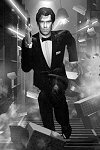 |
| |
GoldenEye 64 game designer Martin Hollis takes a look back at the making of the best selling James Bond videogame of all time...
|
|
The Making of GoldenEye 64
26th May 2006
Picture the scene: It's E3. June 1997. GoldenEye the movie came out an embarrassing 2 years ago. The next Bond film has already finished shooting. It's called Tomorrow Never Dies. It will be released in a few months. The world's most famous FPS, Doom is ancient history. It is four years old. Quake is last year's game, but still hot. Featuring polygonal backgrounds and characters, it is the new king of the shooters, having sold around 1 million copies. But Doom and Quake have had very limited success on consoles. PCs and FPSers go together. Any other way of thinking is heresy. Customers don't like their FPSing on console.
Unfortunately for us, the GoldenEye team, we are just putting the finishing touches to 2 and a half years of work on a FPSer for the Nintendo 64. GoldenEye 007 the game is due out soon. It would be fair to say that critical expectations were very low. It would also be fair to say that we, the GoldenEye team, didn't realize this, mercifully. To quote one reviewer: 'Everyone was dubious about the prospect of a video game version of a rather ropey Bond movie. The fact that it was going to be a first person shooter on a home console made it all the more likely that this game was going to be poor.' Accordingly, no-one who played it at the show seemed terribly impressed. Worse, most people just walked by without playing.
Mark Edmonds and myself were slightly depressed over GoldenEye's reception. But still we went back to Rare, having only a few weeks left in which to fix about 500 bugs. Later that month, the NTSC version is finished, much to the relief of the team. We did our best. We worked hard. Very hard. We're hoping people will like the game. |
|
 |
Fast-forward to the future. One month later, July 1997 GoldenEye is released, to modest critical and commercial success. In 1998, Half-Life is released for PC. GoldenEye keeps on selling. In the same year, Metal Gear Solid is released for PlayStation. GoldenEye keeps on.
2000 brings Perfect Dark. GoldenEye keeps on. 2002: Splinter Cell. And here we are back in 2004. How time flies. GoldenEye has stopped selling. It's getting old. Technology has moved on. Plus, you can get it for a few bucks on ebay.
To date, GoldenEye has sold more than 8 million units. In the US it is the best selling N64 game ever. Ahead of Mario Kart in second place. Ahead of Super Mario 64 in third place. Ahead of Ocarina of Time in fourth place. I consider Mario 64 and Ocarina to be vastly superior to GoldenEye. And both have a better franchise for gaming. People expect Mario and Zelda games to be good. They expect movie licenses to be rubbish. Why did GoldenEye sell better? Why did it sell better than Ocarina? Why did it sell better than Perfect Dark? Why did it sell better than all those other Bond games? Why did it sell better than Doom? And Quake?
This is the main theme of my talk. Why did GoldenEye sell so well? Interleaved with anecdotes and some history, I'll be returning to this question several times. I'll do my best to answer it.

Above: The original "GoldenEye 64" game
released in 1997 by RareWare. |
|
The GoldenEye story begins in Nov 1994. I had been at Rare just one year. We'd recently finished work on Killer Instinct Coin-Op. I was second programmer. It was roughly a 10 person 1 year project. Now I was heavily researching the new Ultra 64 graphics capabilities, and wondering what I would be doing next. There was a rumour going around that Rare had been approached by Nintendo to do a game for a new Bond film. But nobody was that enthused. Tim Stamper the MD, and a few other people from the Donkey Kong Country team had gone to the publicity party and met the cast, but the project fizzled out after that point. Being ambitious, I suggested to Tim that I should direct a new team to make the game, and that Rare should take on the project. I vaguely proposed it would be a 3D shooting game.
|
Thinking back, I could have thought one of two things. I could have thought 'Oh boy, movie to game conversions suck'. But I didn't. Alternatively, I could have thought 'Ker-ching! Bond is a great franchise. This game will sell and sell!'. But I didn't. I wasn't really focused on the business side of things at that time, I was just focused on making the game great. Instead of these things, I thought 'Bond: cool!'. Putting on my business head today, and trying to explain the success of GoldenEye, I can say the following: Obviously Bond is a great license. For games, I think it is one of the best film licenses there is. The Bond franchise is incredibly popular, which gives you great visibility. The Bond universe as depicted in the films and the books is very broad, and provides you with many characters, locations and story elements, not to mention gadgets. Never underestimate how much work it is to create a universe. More importantly for games, you get game-like elements that you can actually use. Lastly Bond himself is a strong character, and much loved. He may be stereotypical, but that is perfect for an action-based video game. Everybody knows exactly what he is like – you don't even have to show him on screen during gameplay. So the first factor in the success of GoldenEye is Bond. But that isn't enough. The other Bond games haven't matched the success of GoldenEye. Why?
Come March 1995 work was underway with a team of new recruits. Mark Edmonds, my first ever interviewee, was programmer, Karl Hilton was background artist and B. Jones was character artist. I had prepared my first ever game design, a 9 page document. The first sentence of that design may be a surprise to you. It was: 'The game will be similar to Virtua Cop in terms of gameplay'. For those not familiar with Virtua Cop it is an old classic, an on-rails shooter, made by Sega, and released first in the arcades. So yes, for the first months, GoldenEye was partly envisioned as a simple on-rails shooter only with no lightgun. But I also wanted it to be a FPS. At this point the team was happy to contemplate making two modes for the game, an on-rails mode and a FPS mode. Yes, there was some vagueness here. You have to understand, we didn't know what the control of the N64 would be like, so it made designing the control system difficult at such an early stage. We didn't have any N64s, or anything like them.
I believe very strongly in having and declaring a strong model for your game design. In a way this means, where are we going to steal ideas from? But more importantly, it communicates to those on the team what the game will be like. Saying 'it will be like X' doesn't necessarily make a game derivative, because you can go on to say 'Unlike X, …'. The key is communication. If you reference a specific model, and mention a few changes, it can save a hundred pages of description. In fact, it is better than that 100 pages, because there are no unanswered questions. Any question can be answered with reference to the model.
So, in the specific case of GoldenEye, and with the benefit of hindsight, the gameplay model was Virtua Cop with a bit of Doom, plus some Mario 64. The theme or setting was (obviously) the Bond universe and particularly GoldenEye. Many of the visual effects and kinetic moments I took from Hard Boiled or other John Woo flicks. Especially, things exploding. Visually, there's more to that than you might think.
These strong models each contributed to
the final game significantly. We ended up with innovative
gameplay, in part because we had Virtua Cop features in
a FPS: A gun that only holds 7 bullets and a reload button,
lots of position dependant hit animations, innocents you
shouldn't kill, and an aiming mode. When you press R in
GoldenEye, the game basically switches to a Virtua Cop
mode. Perhaps more importantly following the lead from
Virtua Cop, the game was filled with action. There was
lots to do, with very few pauses. Following the lead from
Virtua Cop and Doom, the controls were accessible. You
could get a long way just using analog left-right, fire
and reload. One dimension and two buttons. Try playing
Quake or Halo like that. From Mario 64, I took the idea
of 5 missions per level. Yes, we changed it from the Mario
format, which was attempt-one-mission-per-play, but the
idea for the huge variety of missions within a level came
from Mario 64.
|
|
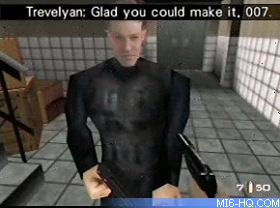
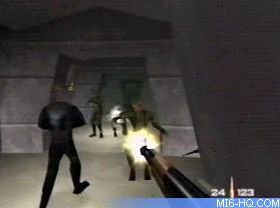
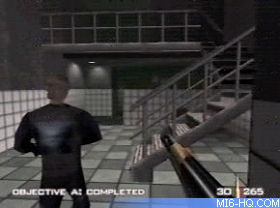 |
We milked the Bond universe in many ways. For example gadgets,
I compiled a list of about 40 gadgets from various Bond films,
most of which were modelled, and then Dave and Duncan tried to
find levels where we could use them. This is backwards game design,
but it worked very well. These models were the game design; there
was very little written down on paper. And the models were researched
and milked extensively. And, importantly, they all gelled together
very well. These things helped to make the gameplay and the game
style what it is.
So admittedly the game control and even exact genre were very vague in the original document, but the design was very concrete in every other way. It listed which levels from the film would be used, which characters would feature, what weapons there would be, and what visual effects there would be. So it listed the Dam, the Frigate, the Control Centre, Statue Park, all that. It described some story digression from the film. Basically I just wanted to use all the good sets from the movie and put Bond in there, even if the movie didn't. It listed sniper rifles, throwing knives and magnetic bombs, plus a few gadgets. It listed bullet holes in walls and cartridge cases being ejected from guns. It described having lots of animation and reactions for the characters. Mostly we stuck to all this, about 80%. The design also described the AI. And I quote 'Unlike Virtua-Cop, the characters will react to the player's movements and actions intelligently. They will try to achieve their own goals, based on information from their eyes and ears. All characters will try to survive, but in addition to this, they might be trying to reach an alarm switch, rescue their comrade, obey an order, play dead, hide under a table, or reach an exit'. unquote. Well, that last sentence. It is funny how you can describe more features in one sentence than ten years of progress has managed to achieve. I'm looking forward to the day I see an NPC hide under a table. Still, we managed the 'reach an alarm switch' thing. I'll come back to AI later.
 |
|
So in the first year when we were without any development systems, Mark focused on creating an art pipeline to get 3D graphics from our art packages into N64 data structures, creating an engine that could draw skinned characters.
Karl constructed levels based on the film sets, which we visited several times. And Bea constructed characters based on the photos of people and costumes we had. Later on Duncan Botwood joined the team and constructed levels. All of us immersed ourselves in the Bond universe. |
One important factor was this. The level creators, or architects were working without much level design, by which I mean often they had no player start points or exits in mind. Certainly they didn't think about enemy positions or object positions. Their job was simply to produce an interesting space. After the levels were made, Dave or sometimes Duncan would be faced with filling them with objectives, enemies, and stuff. The benefit of this sloppy unplanned approach was that many of the levels in the game have a realistic and non-linear feel. There are rooms with no direct relevance to the level. There are multiple routes across the level. This is an anti-game design approach, frankly. It is inefficient because much of the level is unnecessary to the gameplay. But it contributes to a greater sense of freedom, and also realism. And in turn this sense of freedom and realism contributed enormously to the success of the game.
I mentioned we didn't have an N64 or anything like one. The closest we had was an SGI Onyx or two. Thankfully, as it turned out, the N64 could render triangles much faster than the SGI Onyx. This was shocking as the list price of the Onyx was $250K dollars, and the N64 launched for about 1000th of this price. That's progress. And it totally saved us, as several of the backgrounds rendered at about 2Hz (2 fps) on the Onyx, without even drawing enemies, objects, or Bond's gun. My attitude was always, well, if it runs at all on the Onyx, we can probably get it to run at about 30Hz on the final hardware. We had a target of 30Hz for frame-rate. As a rule of thumb I allocated 1/3 of the graphics processing to rendering the background, 1/3 to rendering the characters, 1/3 to the objects, and 1/3 to Bond's gun (and 10% to the audio).
This kind of accounting partly explains why we didn't always hit 30Hz. The fact is, because we always knew the software had slack in for future improvement, and because the hardware was supposed to get faster with a later spin, we felt we could be optimistic about framerate. We were relying on future ingenuity, but in the end the last few optimizations yield less than you hoped, and the final hardware is clocked slower than you hoped. Frankly I think the benefit from having 50% more triangles in the backgrounds outweighed the cost of running at 20Hz in some places. I think the benefit of being able to have 8 characters on screen, outweighs the cost of running at 10Hz. The benefit of having thick smoke outweighs the cost of running at 10Hz. I don't think the same decisions are correct today, with the more powerful hardware. |
|
 |
It took Mark and myself, mostly Mark, about that first year to get an art pipeline and engine working, so you could move around, and the enemies could move. They weren't smart back then.
After the first year, and we missed our first deadline, management started to get very concerned, and gave us more people. I guess it was either that or cancel the project, and the work we had to show was impressive enough not to cancel. So one year into the project we added more staff, Dave Doak who I've mentioned already was responsible for much of the mission and level designs, and much of the level specific AI scripting. We played through Mario 64 together and it really inspired us in terms of variety of objective design. Six months later I hired Steve Ellis. He assisted with many things, including implementing multiplayer, which was a complete afterthought.
I should mention that the entire team was very green. 8 of us had never worked on a game. Andy Smith had worked on a few at Rare. I had worked on one at Rare and written countless games back in prehistory as a hobbyist, but those one-person games don't count really do they? But overall the team was very talented and very dedicated. When I selected people I was looking for three things: talent in their field (obviously), an affection for the Bond universe, and a deep understanding of games. Six of the people on the project could easily be given the job title game designer. This is a ridiculously high ratio, and explains a lot. One person can't design an original game, it just isn't humanly possible. Six have a chance, with proper coordination. Regarding dedication, several of us commonly did 80 hour weeks and occasional 120 hour weeks. I averaged an 80 hour week over the 2 and a half years of the project. The talent and dedication of the team was pivotal to the quality of the game. One more reason for success.
The last year was spent actually making the game. Prior to this we had really been making an engine, and a load of art assets. AI was written and polished, levels were set-up, optimized, and fixed-up. A lot of people talk about the AI in GoldenEye. In my view, the AI is not all that intelligent. There's a guard. He'd see you. Either he'd attack you, or maybe run to activate an alarm. Some had patrol routes, some didn't, just stood still. It was revolutionary for the time, but still not very clever.
The important thing is to show the player the AI. There's no point having sophisticated AI that the player doesn't notice.
Your NPC's can be insightfully discussing the meaning of life, but the player won't notice if the game requires that they swing around a corner and fill the bad guys with bullets. So the intelligence has to be evident. The game mechanics have to showcase the AI. The level setup has to showcase the AI. And it all has to make an actual difference in actual gameplay. |
|
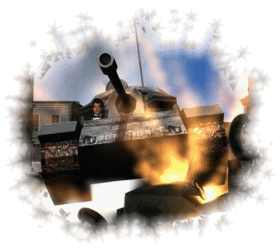 |
Let me give two concrete examples.
The first is an example of game mechanics. It so happens that enemies in GoldenEye can't see through many windows in the game. The player can see through, and shoot through, but the enemies just won't see through. The window is opaque to them. This might seem like a bug. It is certainly unrealistic. It is an example of unrealistic gameplay. And, as it happens, it is pretty good gameplay. It means you can spy on people more easily. Which makes sense for a Bond game. And that is fun. Realism isn't relevant to good gameplay. Only verisimilitude matters. The art is in knowing what you can get away with. Sometimes as a designer you are surprised how much players don't object to, for example enemies that can't see through most windows. Other times, players are very sensitive to unrealism, for example if you shoot someone and somebody else nearby doesn't react.
The window thing favours stealth, where stealth means: not shooting your weapon all the time. If you refrain, you have the element of surprise on your side in more encounters. You know where they are, and they don't know where you are.
It also increases the amount of tactics and strategy in the game, because you can see what the enemy is doing. If you can see what they are doing, you can think about it. In most shooting games, the enemy can see you at much the same time you can see them, which eliminates all strategy.
The second example is of level setup showcasing the AI. Bond enters a room and there are three guards. One runs to the alarm, the other two guards reach for their weapons. Bond faces a dilemma: who to shoot first? This scene, taken pretty much directly from one of the earlier screenplays of the movie was one of the most exciting scenes for me, in terms of gameplay and AI innovation. I'd never seen anything like it in a game. Consequently, alarms, and people running to them was a major part of the AI of the game. But the times when this cleverness on the part of the programmers and designers really counted, was when you could see the NPC deciding what to do, and doing it. That is to say, when it is showcased.
Having good or revolutionary AI is nice, but you only score points when you show it to the player by engineering situations and mechanics to do so. The AI in GoldenEye was held up to players so they could see it, and it made a difference to gameplay, especially in regards to strategy.
Another way we encouraged strategy was with the option for stealth. You often had the choice to use your silenced pistol, rather than a faster, more powerful weapon. The game would count how many shots you fired. Two shots from the PPK was considered ‘silent'. Two shots from the AK47 was considered ‘loud' and guards nearby would become alarmed, and would know where you were. If you didn't shoot for a few seconds, the count would be reset. Not very realistic. But very effective at balancing stealthy play. It encouraged single-shot use of the weapons, which in turn encouraged accuracy. This worked well together with the single head-shot kills rule. But all this encouraged strategy, as you could choose a method to play a level, and you would benefit from thinking before shooting every time. Encouraging strategy was one more reason for the success of the game.
Unfortunately, there isn't more time to cover more reasons. However, I'd like to recap the reasons I covered:
- Bond is a great universe for games
- We mined it extensively
- We had a very talented team
- Original design: We used strong and compatible models of Virtua Cop and Doom
- Later change: We took inspiration for variety and number of objectives from Mario 64
- We used stylish filmic models for violence to people and objects, interactive background
- Architecture: We creating levels without plans for how they will be played
- We'll find a use!: We creating gadgets and weapons without plans for how or where they will be used
- We implemented ambitious AI, to execute specific planned gameplay moments
- We took pains to show the AI to the player at every opportunity
- We nurtured strategy in a genre that doesn't usually allow it
By Martin Hollis - GoldenEye 64 game designer.
Originally presented at the 2004 European Developer's Forum, 2004-09-02
Martin Hollis, renowned game industry veteran and producer/director of the critically acclaimed first-person shooter GoldenEye007, established Zoonami in 2000. Zoonami Ltd is an independent producer and developer of entertainment software for video game consoles based in Cambridge, UK.